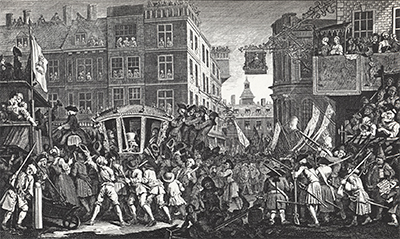The Industrious 'Prentice Lord-Mayor of London, created in the year 1747 AD, is one of a set of copper plates that were engraved by William Hogarth.
The plate, the twelfth and final engraving in the Industry and Idleness series, depicts the Lord-Mayor of London on the day of his inauguration as he rides in the State Coach through the London streets. The scene that is depicted within the engraving, from which printed copies were made and sold to the general public for one shilling each, represents the final chapter of a cautionary tale in which vice is punished and virtue is rewarded.
Hogarth, known to have found inspiration for his artistic projects in the streets of the capital, often sought to convey a moral message in his artworks in order to persuade his audience to lead more righteous lives. The two apprentices that feature in the set of engravings, one industrious and the other idle, begin their life’s journey in identical circumstances yet in the last two plates the idle apprentice is hanged at Tyburn and the industrious apprentice becomes the Lord-Mayor of London. Hard work, benefiting society as whole, has allowed the hard-working apprentice to climb the social ladder.
Francis Goodchild, the industrious apprentice who was been made Lord-Mayor of London, peers through the window of his carriage while brandishing the ceremonial sword-of-state and wearing a top-hat. A crowd of revellers have gathered in the streets to observe the mayoral procession while the town militia, armed with flintlock muskets, are visible on the left-hand side of the engraving. The city elite, observing the scene from the windows of their townhouses or from the deck of a balcony on the left-hand side of the engraving, bear witness to Goodchild's moment of triumph.
Seven figures, eager to gain a better view of the day's festivities, are sitting on the roof of one of the townhouses. The number seven could refer to the seventh day in which God, having created the earth in six days, rested or to the good fortune that Goodchild has experienced as a direct consequence of his hard work. A Bible passage, that is verse sixteen of the third chapter of Proverbs which talks of longevity as well as the accumulation of honour and riches, summarises the moral message of the engraving.




